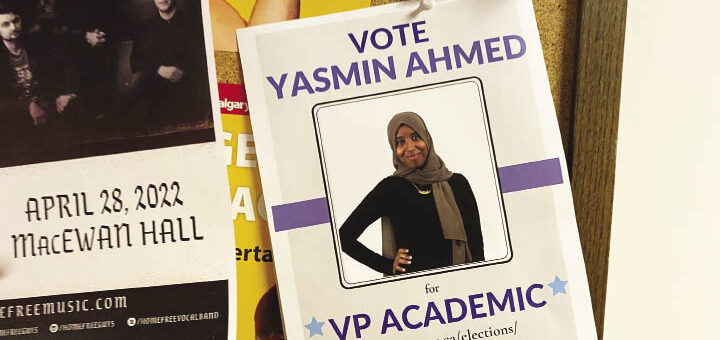Another year, another low voter turnout, are student elections important anymore?

By Noel Ormita, Contributor
A new Student Association of Mount Royal University (SAMRU) Representative Executive Council (REC) was elected on March 17. Students went to the polls, in-person and online from March 14-17, but results revealed a majority of students didn’t cast a vote.
Joseph Nguyen, the incoming SAMRU president for the 2022-23 school year begins his second term on REC in the fall, previously serving as vice president of Student Affairs.
“This year, our turnout was only close to five per cent,” Nguyen said.
COVID-19 stress and burnout
This year had a fall semester of a ‘new normal’ with in-person learning, followed by a winter semester of more online learning and a phased return to classes with the threat of a faculty strike that would’ve caused more disruption for students. It was a year of stress, anxiety and uncertainty for many.
Rio Valencerina, a manager of governance and advocacy at Southern Alberta Institute of Technology Student Association (SAITSA), has seen that lack of student participation is not just an Mount Royal University (MRU) issue.
“I’ve talked about this with our Elections Officer as well, a lot of it seems to be that online burnout,” Valencerina said.
The online learning also meant students aren’t interacting on campus with peers, through clubs and through their student associations.
“At SAIT, a lot of students are two year diploma students. Some of them have never been on campus, and they’re graduating this year,” Valencerina said.
Low turnout is nothing new
Though the pandemic may have caused a significant impact on the ability for students to vote, past SAMRU election results reveal past years saw low turnouts as well.
Duane Bratt, political science professor at MRU thinks the low voter turnout is caused by the lack of interest from students themselves.
“Pre-COVID, during COVID, it doesn’t matter, the turnout rate is very, very low. This is not a new phenomenon,” Bratt said. “Do students see the value in student elections? Do they see the value in what the student government does? Do they understand the money that’s at play and the fees that students pay and the way that that is spent by the student government? I don’t think they do.”
The most recent March election saw the lowest voter turnout at 4.8 per cent, ultimately less than 600 students determined the next leaders of MRU’s student government.
Candidates and lack of options
When factoring in the number of candidates that run in student elections into the data, the result leads to another reason why students aren’t voting— it’s the lack of choices.
“This past election for us, voter turnout and even … candidates we had running actually decreased a lot,” Valencerina said.
SAITSA’s governing body follows a policy governance structure, where the president and vice president are not elected directly by students but instead by a board of directors who chooses the roles amongst themselves.
“We ended up not running an election because we’re supposed to have at least nine or at least 10 people running for nine positions on the board. And this year, we only had seven,” Valencerina said.
University of Calgary’s Student Union elections that took place in March saw for the first time the re-election of their president, Nicole Schmidt, unopposed. Nguyen also ran unopposed for the SAMRU elections and was both relieved and disappointed as he looked forward to the competition.
“A bunch of my campaign ideas I came up with, went off the ball,” Nguyen said. “It’s good for me, because I get to focus on actual advocacy work.”
The power of a vote
Student governments have various roles in and out of the community.
“They have large budgets, because of the student fees that are put out. So they make a lot of spending decisions, and they play a role in the overall governance of the university,” Bratt said. “They’ll sit on university committees with administration and faculty.”
“It was awareness of an issue that was brought to the government’s attention, and then responded to because there was that conversation between the students and the government,” Valencerina said.
One of the policies SAMRU advocated for was a ban on online proctoring, giving students more freedom with already difficult online learning. Not voting and not having a say on who represents students can have major consequences.
“It means that a very small minority speaks on behalf of the large majority,” Bratt said. “If you’ve got turnout that is so low, that means the winning candidates have even a smaller percentage, but they get 100 per cent of the authority after an election.”
With these voting turnout rates on campuses, it doesn’t take much to win a position that holds a lot of power.
“It’s not hard to hijack an election on student grounds. Because all you [have] to do is mobilize a couple hundred students either through a student club or a certain degree program, or residence or what have you,” Bratt said.
In his term as president, Nguyen aims to create opportunities for student government and students to have clear and open communication channels to tackle issues that matter to students.
“It’s your way to put your voice out and it’s your way to make sure that who sits at the table represents you.”





